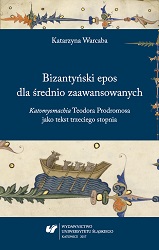Bizantyński epos dla średnio zaawansowanych. "Katomyomachia" Teodora Prodromosa jako tekst trzeciego stopnia
A Byzantine epic for intermediate students. Theodore Prodromos’s “Katomyomachia” as a text in the third degree
Author(s): Katarzyna Warcaba
Subject(s): Literary Texts, Studies of Literature, Philology
Published by: Wydawnictwo Uniwersytetu Śląskiego
Keywords: Byzantine literature; Theodore Prodromos; Katomyomachia; Bizantium; antiquity
Summary/Abstract: The analysis of Homer’s influence upon the literatures of various periods and societies is one of the most extensive research subjects associated with literary reception. The Iliad and the Odyssey remain until today one of the most recognisable literary works which arose in European culture, and the research in the poems themselves has been conducted continuously, from the beginning of the existence of philology as a field of study. Unarguably, Homer was also the most popular author in Byzantium, which is testified by the very number of the manuscripts which contain works which are ascribed to the Poet. He was present at all stages of education, although only few people studied the great works of the Greek master in earnest. The majority of the students – the future intellectuals of Constantinople – engaged above all the first book of the Iliad or summaries of this part, whereas Batrachomyomachia, which is attributed to the Poet and which acts as a stepping stone to the reading of the epic poems was familiar to all of those who accomplished the “intermediate” stage of the system of education. In the Byzantine period the text saw the appearance of its imitator, i.e. Theodore Prodromos, the author of Katomyomachia, which is the subject of the present work. The book consists of an introductory part which includes the following: information about the author and the circumstances in which “The War Between Cats and Mice” arose, and an overview of the presence of cat and mice in ancient and Byzantine literature. The bulk of the work consists of an analysis of the text according to a transtextual approach which was put forward by Gerard Genette in an essay entitled Palimpsests. Literature in the Second Degree”. Due to the fact that Katomyomachia constitutes a literary palimpsest based on a different palimpsest, I decided to suggest a concept of a text in the third degree, in an analogous manner to Genette’s concept. The analysis leads to an attempt at establishing the possible conceptual areas for which Prodromos’s text was intended. The study is accompanied by translations of two Greek texts, Katomyomachia and a text which is attributed to Prodromos, Schede tou myos, into Polish.
Series: Filologia Klasyczna
- E-ISBN-13: 978-83-226-3237-6
- Print-ISBN-13: 978-83-226-3236-9
- Page Count: 204
- Publication Year: 2017
- Language: Polish
- eBook-PDF
- Table of Content
- Introduction

